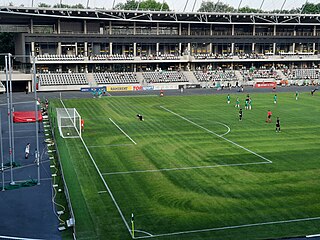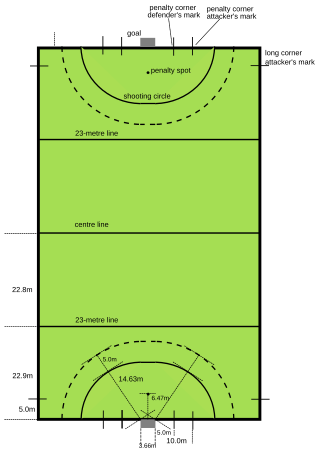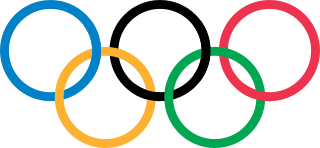
Field hockey is a team sport structured in standard hockey format, in which each team plays with 11 players in total, made up of 10 field players and a goalkeeper. Teams must move a hockey ball around a field by hitting it with a hockey stick towards the rival team's shooting circle and then into the goal. The match is won by the team that scores the most goals. Matches are played on grass, watered turf, artificial turf, or indoor boarded surface.

In many team sports that involve scoring goals, the goalkeeper is a designated player charged with directly preventing the opposing team from scoring by blocking or intercepting opposing shots on goal. Such positions exist in bandy, rink bandy, camogie, association football, Gaelic football, international rules football, floorball, handball, hurling, field hockey, ice hockey, roller hockey, lacrosse, ringette, rinkball, water polo, and shinty, as well as in other sports.
In cricket, an umpire is a person who has the authority to make decisions about events on the cricket field according to the Laws of Cricket. Besides making decisions about legality of delivery, appeals for wickets and general conduct of the Game in a legal manner, the umpire also keeps a record of the deliveries and announces the completion of an over.

An umpire is an official in a variety of sports and competition, responsible for enforcing the rules of the sport, including sportsmanship decisions such as ejection.

An own goal occurs in sports when a player performs actions that result in the player scoring points for the opposition, such as when a football player puts a ball into their own net.

A referee is an official, in a variety of sports and competition, responsible for enforcing the rules of the sport, including sportsmanship decisions such as ejection. The official tasked with this job may be known by a variety of other titles depending on the sport, including umpire, judge, arbiter (chess), commissaire, or technical official. Referees may be assisted by umpires, linesmen, timekeepers, touch judges, or video review officials.

In cricket, a no-ball is a type of illegal delivery to a batter. It is also a type of extra, being the run awarded to the batting team as a consequence of the illegal delivery. For most cricket games, especially amateur, the definition of all forms of no-ball is from the MCC Laws of Cricket.

In association football, the referee is the person responsible for interpreting and enforcing the Laws of the Game during a match. The referee is the final decision-making authority on all facts connected with play, and is the match official with the authority to start and stop play and impose disciplinary action against players and coaches during a match.

Indoor hockey is an indoor variant of field hockey. It is similar to the outdoor game in that two teams compete to move a hard ball into the goal of the opposing side using hockey sticks. Indoor hockey is played on a smaller area and between smaller teams than field hockey and the sidelines are replaced by solid barriers from which the ball rebounds and remains in play.
Instant replay or action replay is a video reproduction of something that recently occurred which was both shot and broadcast live.

The laws of Australian rules football were first defined by the Melbourne Football Club in 1859 and have been amended over the years as Australian rules football evolved into its modern form. The Australian Football Council (AFC), was formed in 1905 and became responsible for the laws, although individual leagues retained a wide discretion to vary them. Following the restructure of the Victorian Football League's competition as a national competition and the League's renaming to be the Australian Football League (AFL), since 1994, the rules for the game have been maintained by the AFL through its Commission and its Competition Committee.

In field hockey, a penalty corner, sometimes known as a short corner, is a penalty given against the defending team. It is predominantly awarded for a defensive infringement in the penalty circle or for a deliberate infringement within the defensive 23-metre area. They are eagerly sought by attacking players and provide an excellent opportunity to score. There are particular rules for that only apply at penalty corners and players develop specialist skills, such as the drag flick, for this particular phase in the game.

The 2010 Men's Hockey World Cup was the 12th edition of Men's Hockey World Cup, the quadrennial world championship for men's national field hockey teams organized by the International Hockey Federation. It was held from 28 February to 13 March 2010 in New Delhi, India.

Rugby league match officials are responsible for fairly enforcing the Laws of the Game from a neutral point of view during a match of rugby league football and imposing penalties for deliberate breaches of these Laws. The most senior match official is the referee. They may be assisted by a range of other officials depending on the level and rules of the competition.

Field hockey at the 2016 Summer Olympics in Rio de Janeiro took place from 6 to 19 August at the Olympic Hockey Centre in Deodoro. The competition had instituted several changes in the format and structure from the 2012 Summer Olympics. Twenty-four teams competed in the tournament.

A hockey pitch is the playing surface for the game of field hockey. Historically, the game was played on natural turf (grass) and nowadays it is predominantly played on an artificial turf. The transition to artificial pitches came during the 1970s and was made mandatory for major competitions in 1976. All the lines, markings and goal specifications are outlined by the International Hockey Federation in "The Rules of Hockey".

In field hockey, a penalty stroke, sometimes known as a penalty flick, is the most severe penalty given. It is predominantly awarded when a foul has prevented a certain goal from being scored or for a deliberate infringement by a defender in the penalty circle.
A penalty shootout is a method used in field hockey to decide which team progresses to the next stage of a tournament following a tied game. Two methods have been used: the original penalty stroke competition is a best-of-five penalty strokes with sudden death if scores were level after five strokes. An alternate penalty shoot-out competition was introduced at major tournaments in 2011. Sometimes known as a penalty shuffle, the method is similar to penalty shots in ice hockey and consists of one-on-ones between an attacking player and a goalkeeper. Up to 2013, up to two 7.5-minute golden goal periods were played first; that method ceased after.

Futsal began in the 1930s in South America as a version of association football, taking elements of its parent game into an indoor format so players could still play during inclement weather. Over the years, both sports have developed, creating a situation where the two sports share common traits while also hosting various differences.

The women's field hockey tournament at the 2024 Summer Olympics will be the 12th edition of the field hockey event for women at the Summer Olympics. It will take place from 27 July to 9 August 2024. All games will be played at the Stade Yves-du-Manoir in Paris, France.



















